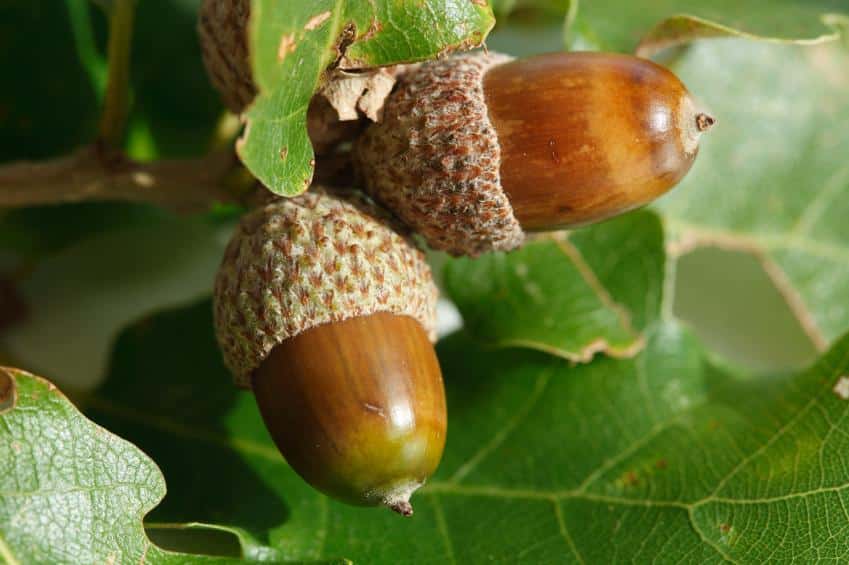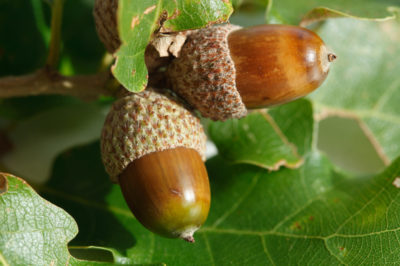America and the Northern Hemisphere are home to many varieties of oaks. Oaks have been used for ceremony, food, medicine and building for as long as humans have been around. In many traditions, the oak is revered as a sacred tree.
Oaks were used as medicine and food for millennia. Many Native American groups used oak to treat bleeding, tumors, swelling and dysentery. European herbalists used oak as a diuretic and as an antidote to poison. Snuff made from powdered root was used to treat tuberculosis. The leaves have been employed to promote wound healing. Oak has been used as a Quinine substitute in the treatment of fevers.
Tannins provide many of the healing properties of oak. Tannins bind with proteins in tissues, making a barrier resistant to bacterial invasion. Tannins strengthen tissues and blood vessels. They reduce inflammation and irritation, especially of skin and mucus membranes.
Modern scientific research confirms that oak possesses the following healing properties: astringent, fever reducing, tonic, antiseptic, anti-viral, anti-tumor, and anti-inflammatory actions. In addition, oak has been used to get rid of worms and other parasites.
The plant parts used for healing include the inner bark, leaves and acorns.
Oak is excellent for controlling loose stools. Either a tincture (alcohol extract) or decoction (boiled tea) of root bark is effective. Decoctions are used to promote healing of bleeding gums when used as a mouthwash. Finely powdered dried inner bark has been used to control nosebleeds. Oak is said to relieve poor digestion. It has been used to treat ulcers internally and externally. Finely powdered dried inner bark can be sprinkled on external ulcers to soothe, reduce swelling, prevent infection and strengthen tissue. A decoction or tincture can be used to heal internal ulcers. Compresses made from a root bark decoction soothe and shrink hemorrhoids, varicose veins and bruises. A bark decoction can be used as a gargle to relieve a sore throat. Skin problems such as rashes, irritation and swelling may be relieved with the application of poultices or compresses made from the root bark or leaves. Oak has been used in the treatment of cholera and gonorrhea. Decoctions have been used as douches to treat vaginal infections
Leaves may be used fresh for first aid in the field. They can be softened by immersing them in boiling water or steaming until limp. If boiling water is not available, the leaves may be softened by crushing them. Apply the leaves topically to the affected area as an antiseptic, soothing poultice to reduce swelling, skin irritation or bleeding.
The hidden secrets of making herbal medicines…right at your fingertips!
Acorns are soaked to remove tannins prior to using the acorn meat for food. The tannin rich soaking water has antiseptic and anti-viral properties. It may be used as a wash to relieve skin irritations from rashes, minor burns and poison ivy.
To prepare a decoction of oak, use 1 teaspoon of dried inner bark per cup of water. Simmer the herb and water, covered, for 20 minutes. Strain the herb from the liquid before using the decoction. If using internally, drink 1 cupful of the decoction 3 times daily. However if the decoction is being used to relieve loose stools, drink one-fourth cup after each loose stool.
If preparing a tincture, use a spirit that contains 60 percent alcohol. Herbalists recommend that 1-2 milliliters may be consumed three times daily.
Fresh leaves may be gathered for first aid as needed. The inner bark is the most useful medicinal part of the oak. It is bitter and astringent in taste. The inner bark is best gathered in spring from roots protruding through the ground. Dry it and store the bark in a cool dark place. Acorns are gathered in the fall.
Oak bark combines well with chamomile for soothing the digestive system. Do not use oak for people who suffer from constipation. Oak is not recommended for large open wounds or for treatment of weeping eczema.
Native Americans relied extensively on acorns for food. Years ago, sacks or baskets of acorns were placed in streams to leach the bitter tannins from them.
One large oak tree can produce 1,000 pounds of acorns in a year. Acorns are nutrient dense foods. They are lower in fat and sugars then many other nuts. Acorns provide about 125 calories per ounce. They are rich in polyunsaturated fats, vitamin B6, copper, manganese and potassium.
Acorns vary in flavor from not bitter to too bitter to eat. Acorns that are produced in one year tend to have a mild flavor while the ones that are only produced every two years are bitter. Oaks that have smooth oval shaped leaves have tastier acorns than those from trees that have pointy lobed shapes. Species that produce acorns with large caps generally yield bitter acorns. Oaks yielding the best tasting acorns include: white oak, live oak and swamp chestnut oaks. Red oaks, turkey oaks and laurel oaks produce bitter acorns. Cream colored acorn meats taste best. Acorns with yellow or orange meat are bitter. Individual trees of the same species produce acorns with differing levels of palatability.
Acorns for food use need to be gathered in the fall to avoid bacterial and insect contamination. Throw away any with insect holes in them.
All acorns require leaching in order to remove the bitter taste of tannins. Some need just a couple of changes of water while others require several. Acorns can be leached by either of two methods.
Method One
Cover the unshelled acorns with cold water. Throw away any that float. As the water turns brown, change it repeatedly. This can take days or even weeks. Using the cold water method is beneficial if you intend to use the acorns as a thickener.
Method Two
Bring a large pot of water to a full boil. Pour in acorns. Throw away the ones that float. As the water turns brown, heat a second large pot of water to boiling. Strain the acorns from the first pot. Place in the second pot. Keep repeating until the acorns are no longer bitter.
To dry leached acorns, fry them in an un-oiled frying pan, stirring frequently, or place them in a 150-200 degree oven for about 20 minutes. They can also be spread on a screen in a single layer to air dry for several weeks.
Store the acorns in a sealed container. They will keep for about 6 months. When you are ready to use the acorns, crack them open with a nut cracker. Acorns stay fresher if shells are not removed until you are ready to use them.
To make acorn flour, place the shelled acorns in a blender and process until fine. Store the flour in a cool dark place. It keeps well in the freezer. Use acorn flour as a nutritious substitute for flour. In baked goods; do not substitute more than one fourth to one half of the regular flour in a recipe with acorn flour. The acorns can be kept in larger pieces and used like any other nut.

